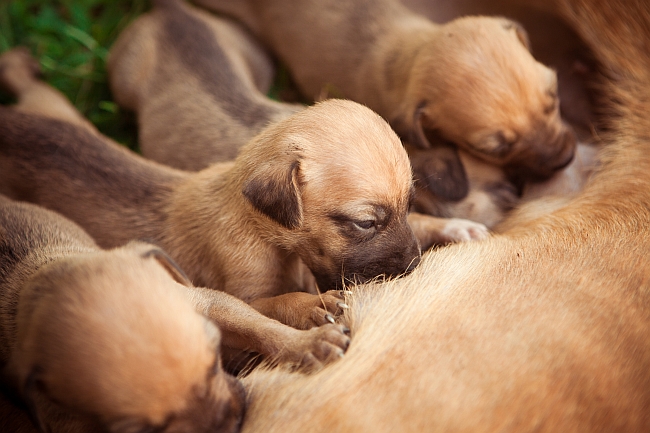
There is nothing more appealing than the idea of being surrounded by puppies all day. Getting to nurture a pregnant dog, caring for newborns, all while making money in the process seems almost too good to be true. However, though it is rewarding work, dog breeding is a taxing labor of love. There are expenses, health risks and heavy responsibilities that fall on the shoulders of the breeder. Find out more about how canine breeding really works.
Breeding Costs and Risks
- Different from that of felines, the industry of canine breeding is more difficult to be a part of, and is highly competitive. In order to be taken seriously they must be licensed, have registration papers for their pets through the American Kennel Club (or whatever country in which they reside), proof of vaccinations, medical records, blood tests, etc. for each of their active breeding hounds.
- Breeders cover the cost of all checkups, vaccinations, and daily care (such as cleaning up after multiple dogs) for the 8 weeks before they are weaned.
- Dog breeders also assume the responsibility of promising to take back the dogs if they should ever be returned, or if the dog owner is no longer able to care for the animal that was purchased.
- They screen/interview all potential owners, and are dedicated to the well-being of their pets and in finding them safe and loving homes. Prospective dog owners may ask a variety of questions about the specific breed. The professional will have to be well-educated about the breed, and about their dogs’ specific bloodlines, and medical history in if he is to be viewed as a credible source.
- Depending on the dog breed, there may be further financial commitments involved in the birthing process. (For example, many Bulldog breeds require c-section operations to ensure a safe birth.) If the pet owner does not possess both the dam (female) and the sire (male), he will also have to research to find a suitable mate, and pay a fair stud fee.
Breeding Process
- Dogs reach sexual maturity around the ages of 6-12 months old, though breeding during the first cycle is not recommended. As a good rule of thumb, dogs should not be bred until they are at a safe age to do so. This will depend on the size of the breed, for example: larger dog breeds would be advised to mate when they are around 18-24 months old, medium dogs around 15-18 months old and small dogs around 12-18 months old.
- The reproductive canine cycle begins with the proestrus period which is 7-9 days, and involves minor swelling and bloody discharge of the dam’s reproductive organs. The next stage is estrus, which lasts between 5-20 days is when a dog is “in heat” and when mating may result in pregnancy. During this time the dam may be brought to the sire for breeding multiple times, though actual mating would only occur once per visit. The entire process of a canine’s reproductive cycle lasts 2-4 weeks. Following the estrus stage is the proestrus cycle which goes on between 55-58 days (when the dam is pregnant) and 60-100 days (when the female is not). Finally, the anestrus stage lasts around 4-5 months and is a time where the female expresses no interest at all in the male.
- Canine gestation is about 63-65 days in length, bringing an average litter of 5-8 puppies. (Note: usually smaller or miniature breeds average 4-5 dogs, while larger breeds can have as many as 8-15 pups in one litter. Of all the dogs breeds, Rhodesian Ridgebacks are most likely to have larger breeds and Pomeranians are most likely to have breeds of 3 puppies or less.

